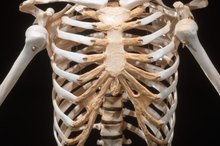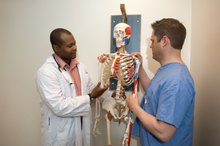Types of Gliding Joints
Gliding joints are also called plane joints or arthrodial joints. The book "Fundamentals Concepts of Anatomy" describes gliding joints as flat bone diarthroses that move in a gliding action that is limited by ligaments. Ligaments are the fibrous tissues that hold bones together. Gliding joints are located in wrists, ankles and spines.
If you are experiencing serious medical symptoms, seek emergency treatment immediately.
Zygapophyseal Joints
According to "Gray's Anatomy for Students," zygapophyseal joints are located between the articular processes of the vertebrae 1. The articular processes are the structures that stick out to the sides and posterior of the vertebral bones of the spine. These processes are connected to the processes of vertebral bone above and below them by tiny ligaments, thus forming small, gliding joints between the vertebral arches.
Wrist Joint
Four Main Parts of a Skeletal System
Learn More
The wrist is made up of eight small bones, known as carpal bones. ; 1977'). The second layer, which sits closest to the bones of the forearm, includes the pisiform, triquetrum, lunate and scaphoid bones.include:
- The second layer
- which sits closest to the bones of the forearm
- includes the pisiform
- triquetrum
- lunate
- scaphoid bones
Ligaments keep these bones in place, resulting in a number of gliding joints.
Ankle Joint
The ankle joint is the gliding joint where the tarsal bones of the foot and the two bones of the lower leg--the tibia and the fibula--meet. Additional gliding joints occur between the tarsal bones themselves, similar to the ones within the wrist. The tarsal bones include the three cuneiform bones, the cuboid, the navicular and the talus bones.
Related Articles
References
- "Gray's Anatomy for Students"; Richard Drake, Ph.D., et al.; 2005
- "Fundamental Concepts of Human Anatomy" 2nd ed.; Michael Shively, D.V.M., Ph.D. and Donald Homan, M.S.; 2004
- "Color Atlas of Anatomy" 5th ed.; Johannes Rohen, M.D., et al.; 1998
- "The Classic Collector's Edition Gray's Anatomy"; Henry Gray, F.R.S., et al.; 1977
- Stanford Children's Health. Anatomy of a Joint.
- Juneja P, Hubbard JB. Anatomy, joints. In: StatPearls. Updated December 19, 2018.
- Tortora & Derrickson () Principles of Anatomy & Physiology, 12th Edition, Pub: Wiley & Sons
- BBC. Types of Joint Movement - Skeletal System.
- Arthritis Foundation. Osteoarthritis.
Writer Bio
Writing professionally since 1998, Dr. Christine Princeton has been published with the American Osteopathic Association and the Society for Teachers of Family Medicine. Dr. Princeton received her degree at Touro University Nevada College of Osteopathic Medicine and works as a physician in the fields of hospital medicine and women's health.









